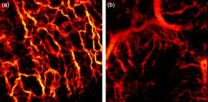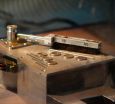(Press-News.org) WASHINGTON--Refueling U.S. Navy vessels, at sea and underway, is a costly endeavor in terms of logistics, time, fiscal constraints and threats to national security and sailors at sea.
In Fiscal Year 2011, the U.S. Navy Military Sea Lift Command, the primary supplier of fuel and oil to the U.S. Navy fleet, delivered nearly 600 million gallons of fuel to Navy vessels underway, operating 15 fleet replenishment oilers around the globe.
From Seawater to CO2
Scientists at the U.S. Naval Research Laboratory are developing a process to extract carbon dioxide (CO2) and produce hydrogen gas (H2) from seawater, subsequently catalytically converting the CO2 and H2 into jet fuel by a gas-to-liquids process.
"The potential payoff is the ability to produce JP-5 fuel stock at sea reducing the logistics tail on fuel delivery with no environmental burden and increasing the Navy's energy security and independence," says research chemist, Dr. Heather Willauer.
NRL has successfully developed and demonstrated technologies for the recovery of CO2 and the production of H2 from seawater using an electrochemical acidification cell, and the conversion of CO2 and H2 to hydrocarbons (organic compounds consisting of hydrogen and carbon) that can be used to produce jet fuel.
"The reduction and hydrogenation of CO2 to form hydrocarbons is accomplished using a catalyst that is similar to those used for Fischer-Tropsch reduction and hydrogenation of carbon monoxide," adds Willauer. "By modifying the surface composition of iron catalysts in fixed-bed reactors, NRL has successfully improved CO2 conversion efficiencies up to 60 percent."
A Renewable Resource
CO2 is an abundant carbon (C) resource in the air and in seawater, with the concentration in the ocean about 140 times greater than that in air. Two to three percent of the CO2 in seawater is dissolved CO2 gas in the form of carbonic acid, one percent is carbonate, and the remaining 96 to 97 percent is bound in bicarbonate. If processes are developed to take advantage of the higher weight per volume concentration of CO2 in seawater, coupled with more efficient catalysts for the heterogeneous catalysis of CO2 and H2, a viable sea-based synthetic fuel process can be envisioned. "With such a process, the Navy could avoid the uncertainties inherent in procuring fuel from foreign sources and/or maintaining long supply lines," Willauer said.
NRL has made significant advances developing carbon capture technologies in the laboratory. In the summer of 2009 a standard commercially available chlorine dioxide cell and an electro-deionization cell were modified to function as electrochemical acidification cells. Using the novel cells both dissolved and bound CO2 were recovered from seawater by re-equilibrating carbonate and bicarbonate to CO2 gas at a seawater pH below 6. In addition to CO2, the cells produced H2 at the cathode as a by-product.
These completed studies assessed the effects of the acidification cell configuration, seawater composition, flow rate, and current on seawater pH levels. The data were used to determine the feasibility of this approach for efficiently extracting large quantities of CO2 from seawater. From these feasibility studies NRL successfully scaled-up and integrated the carbon capture technology into an independent skid to process larger volumes of seawater and evaluate the overall system design and efficiencies.
The major component of the carbon capture skid is a three-chambered electrochemical acidification cell. This cell uses small quantities of electricity to exchange hydrogen ions produced at the anode with sodium ions in the seawater stream. As a result, the seawater is acidified. At the cathode, water is reduced to H2 gas and sodium hydroxide (NaOH) is formed. This basic solution may be re-combined with the acidified seawater to return the seawater to its original pH with no additional chemicals. Current and continuing research using this carbon capture skid demonstrates the continuous efficient production of H2 and the recovery of up to 92 percent of CO2 from seawater.
Located at NRL's Center for Corrosion Science & Engineering facility, Key West, Fla., (NRLKW) the carbon capture skid has been tested using seawater from the Gulf of Mexico to simulate conditions that will be encountered in an actual open ocean process for capturing CO2 from seawater and producing H2 gas. Currently NRL is working on process optimization and scale-up. Once these are completed, initial studies predict that jet fuel from seawater would cost in the range of $3 to $6 per gallon to produce.
How it Works: CO2 + H2 = Jet Fuel
NRL has developed a two-step process in the laboratory to convert the CO2 and H2 gathered from the seawater to liquid hydrocarbons. In the first step, an iron-based catalyst has been developed that can achieve CO2 conversion levels up to 60 percent and decrease unwanted methane production from 97 percent to 25 percent in favor of longer-chain unsaturated hydrocarbons (olefins).
In the second step these olefins can be oligomerized (a chemical process that converts monomers, molecules of low molecular weight, to a compound of higher molecular weight by a finite degree of polymerization) into a liquid containing hydrocarbon molecules in the carbon C9-C16 range, suitable for conversion to jet fuel by a nickel-supported catalyst reaction.
### END
Fueling the fleet, Navy looks to the seas
2012-09-24
ELSE PRESS RELEASES FROM THIS DATE:
Glass half full: Double-strength glass may be within reach
2012-09-24
Glass is strong enough for so much: windshields, buildings and many other things that need to handle high stress without breaking. But scientists wholook at the structure of glass strictly by the numbers believe some of the latest methods from the microelectronics and nanotechnology industry could produceglass that's about twice as strong as the best available today.
Rice University chemist Peter Wolynes is one of them. Wolynes and Rice graduate student Apiwat Wisitsorasak determined in a new study that a process called chemical vapor deposition, which is used industrially ...
Researchers demonstrate cheaper way to produce NFO thin films
2012-09-24
Researchers from North Carolina State University and the Georgia Institute of Technology have demonstrated a less-expensive way to create textured nickel ferrite (NFO) ceramic thin films, which can easily be scaled up to address manufacturing needs. NFO is a magnetic material that holds promise for microwave technologies and next-generation memory devices.
Specifically, this is the first time researchers have used a chemical deposition process to create NFO thin films that are "textured" – meaning they have an aligned crystalline structure. Arraying the crystalline structure ...
3-year, 676-child trial shows effectiveness of low-cost intervention to improve sun protection
2012-09-24
A blistering sunburn during childhood or adolescence more than doubles the adult risk of skin cancer. The accumulation of long-term sun exposure may be equally dangerous. A study from the Colorado School of Public Health and the University of Colorado Cancer Center recently published in the American Journal of Preventive Medicine shows one way to reduce this exposure: a double-blind randomized clinical trial of mailed sun protection packets led to higher frequency of sun protective behaviors including the use of long clothing, hats, shade, sunscreen, and midday sun avoidance.
"This ...
EARTH: Bakken boom and the new Wild West
2012-09-24
Alexandria, VA – Diesel-soaked clothing, 90-hour work weeks, and the constant groaning of a multimillion-dollar oil rig towering overhead: Welcome to life in Williston, N.D., home of the United States' latest oil boom. In this month's issue of EARTH Magazine, R. Tyler Powers, a young geologist thrust into the middle of the new boomtown, offers his perspective on what life is like today in the new Wild West.
Thousands of oil rigs sit atop the Bakken Formation, a Late Devonian to Early Mississippian rock formation that underlies parts of Montana, North Dakota, Saskatchewan ...
Tissues tell the tale: Non-invasive optical technique detects cancer by looking under the skin
2012-09-24
VIDEO:
This is a 2x2x2mm extracted blood vessel structure of basal cell carcinoma in vivo exhibiting a chaotic vascular pattern (left). Virtually cut volume obtained with OCT displaying the embedded blood...
Click here for more information.
WASHINGTON, Sept. 24, 2012—The trained eye of a dermatologist can identify many types of skin lesions, but human sight only goes so far. Now an international team of researchers has developed an advanced optics system to noninvasively ...
Heritability of avoidant and dependent personality disorder traits
2012-09-24
A new twin study from the Norwegian Institute of Public Health shows that the heritability of avoidant and dependent personality disorder traits might be higher than previously reported. People with avoidant personality disorder are often anxious in the company of others, while people with dependent personality disorder feel more secure.
Results from previous studies indicate that genetic factors explain about one third of the individual differences in these personality disorder traits, while the remaining variation is best explained by environmental influences. These ...
Newly discovered molecule could deliver drugs to treat diseases
2012-09-24
MANHATTAN, Kan. -- Kansas State University researchers have discovered a molecule that may be capable of delivering drugs inside the body to treat diseases.
For the first time, researchers have designed and created a membrane-bounded vesicle formed entirely of peptides -- molecules made up of amino acids, the building blocks of protein. The membrane could serve as a new drug delivery system to safely treat cancer and neurodegenerative diseases.
A study led by John Tomich, professor of biochemistry at Kansas State University, has been published in the journal PLOS ONE ...
A windshield wiper for Mars dust is developed
2012-09-24
This press release is available in Spanish.
VIDEO:
A team of researchers at Universidad Carlos III in Madrid has developed a device that works as a windshield wiper to eliminate Mars dust from the sensors on the NASA...
Click here for more information.
Leading energy scientists from the UK and China are joining forces to develop green technology that will revolutionise the way electricity ...
Gas outlets off Spitsbergen are no new phenomenon
2012-09-24
Frequent storms and sub-zero temperatures – nature drove the marine researchers that were assessing gas outlets on the sea bed off the coast of Spitsbergen for four and a half weeks to their limits. Nevertheless the participants were very pleased when they returned: "We were able to gather many samples and data in the affected area. With the submersible JAGO we even managed to form an impression of the sea bed and the gas vents" summarised the chief scientist Professor Dr. Christian Berndt from GEOMAR | Helmholtz Centre for Ocean Research Kiel.
The reason for the expedition ...
Therapeutic impact of cell transplantation aided by magnetic factor
2012-09-24
Putnam Valley, NY. (Sept. 24, 2012) – Two studies in the current issue of Cell Transplantation (21:6), now freely available on-line at http://www.ingentaconnect.com/content/cog/ct/, demonstrate how the use of magnetic particles are a factor that can positively impact on the targeted delivery of transplanted stem cells and to also provide better cell retention.
A research team from the University of British Columbia used focused magnetic stem cell targeting to improve the delivery and transport of mensenchymal stem cells to the retinas of test rats while researchers from ...

